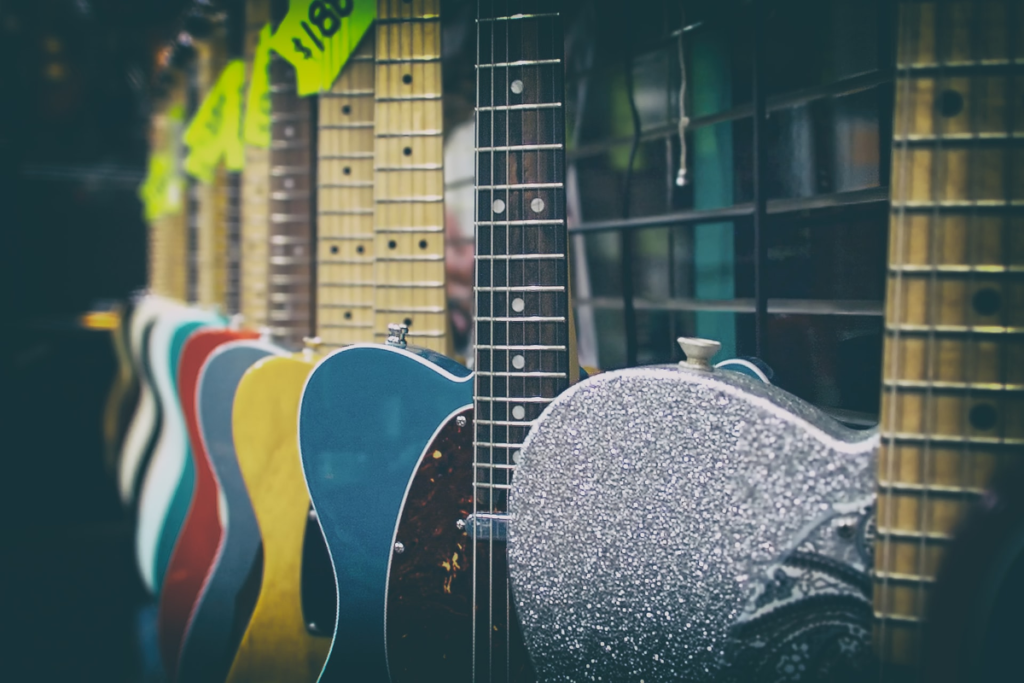Guitar Serial Number Lookup
Try Our Updated Guitar Serial Number Decoders
Are you curious about the history of your guitar? I know that at some point, we all have been. You can find out valuable information by looking for the serial number on the back of your instrument/neck plate or inside the soundhole and entering it into our decoders. This blog post will teach you how to find this information, how to value your guitar and spot a fake.

Have you ever wanted to know more about your guitar but didn’t know what the guitar serial numbers meant?
Guitar players and collectors often wonder how old their guitars are and what their worth in in today’s market.
Many guitar players know that there are guitar serial number lookup decoders online. Our up-to-date serial number decoders can give you detailed information about your guitar, including production year / place of manufacture / batch number / factory code / and production number. This all depends on the brand you’re looking at.
It can also help you avoid getting ripped off if the guitar is a fake.
Suppose you have an old guitar lying around somewhere in your house. Then, try our fantastic decoder tools, you can start looking to see if it’s worth anything.
We share all the information the internet has to offer. If your serial number yields no results, scroll down past the decoder and manually check your number to the nearest result, and you can get a general idea of where your guitar started its life.
It’s simple enough with our Guitar Serial Number Lookup Decoders. Type your serial numbers into our database below, and you’ll get all the information the internet has on the instrument.
At present we have updated serial number decoder for:
- Epiphone Serial Numbers
- Gibson Serial Number Lookup
- Fender Serial Numbers
- Guild Guitars Serial Numbers
- Squire Serial Number Lookup
Serial Number Variations
The structure of a guitar’s serial number determines the year of manufacture for that particular brand.
Every brand employs a distinct coding approach that has evolved frequently throughout time.
Some brands display the same serial numbers on different guitars. The result of this means you end up with overlaps. This causes considerable confusion when establishing what era your guitar is from.
Some brands use a different serial number for every decade.
The external characteristics of the guitar are also crucial to determining its decade of manufacture. For instance, you can check the ‘date code’ on the pots.
It’s essential to use all the experience and know-how the internet offers. The answer is out there somewhere. I strongly recommend joining guitar blogs and forums as many experts can help you.
How To Value Your Guitar?
It is often said that “one man’s trash is another man’s treasure,” and this is especially true for guitarists.
I have seen some guitars on craigslist sell for more than the asking price, merely on speculation of what they might be worth.
At other times, people are content to give away their guitar because they don’t think it is worth anything. So, how do you decide how much your guitar is worth?
There are a few things you need to consider when pricing your guitar. The most critical factors are rarity, condition, and demand.
Obviously, rare guitars in good condition will be worth more than those that are ‘common’ and in poor condition.
In addition, guitars in high demand will also be worth more than those with little or no demand.
Guitars with a big name brand attached to them, such as Fender Stratocasters or Gibson Les Paul, usually sell for higher prices. This is because these brands tend to define the quality of the instrument, and many people want to own one.

Sounds Straightforward Right?
However, some brands are considered just as good if not better than the biggest guitar names. So don’t be discouraged if you don’t have a famous brand name guitar.
There are many different ways to value a guitar. The most common way is to look at similar guitars that have been sold recently and use that as a guide.
You can also get an estimate from a guitar appraiser.
Nonetheless, the best way to determine how much your guitar is worth is to find out the history yourself.
There are a few things you need to do to value your guitar:
- First, decide what type of guitar you have. Is it an electric guitar, acoustic guitar, or classical? Electric guitars are probably the most popular, and they come in different types: solid body, hollow body, semi-hollow body, and bass.
- It would help if you started with a general estimate of your instrument’s value. Have a look at similar guitars that have been recently sold and use that as a guide. Don’t forget to take into account the condition of your guitar, as well as the demand for it.
- If you’re not sure what type of electric guitar you have, many websites have pictures and descriptions of different types. You can also take a picture of your guitar and ask other people on forums or social media sites.
- Second, decide on the condition of your guitar. You can use a simple grading scale to determine how well it’s been kept:
Poor – It has cracks, chips, and worn-out parts. It’s hardly playable, and it probably needs a proper setup and repair.
Fair – It is still playable, but has some cracks, chips, or worn out parts. The sound quality may be poor or average, depending on the damage. There are probably some repairs that need to be completed.
Good – It can still play well enough even though there may be some body or hardware chips and dings. The sound quality is usually pretty good. General wear and tear issues only.
Excellent – There is no damage to any part of the guitar. The sound quality is excellent and has been cared for throughout its life.
- Third, research the demand for your guitar. This can be done by looking online, checking eBay, or Reverb. You can also ask other guitarists what type of guitar they are looking for.
- Fourth, consider the rarity of your guitar. Is it a limited edition, custom shop, signature, or one-of-a-kind? If so, it will be worth more than a guitar that is mass-produced.
- Fifth, have the guitar appraised by a professional. You can find guitar appraisers in your area by doing a quick Google search – just remember to check their credentials first!
How To Tell If My Guitar Serial Number Is Fake or Not?
Here’s a few common telltale signs that will help you determine if your Guitar Serial Number is fake or not.
The most common way to spot a fake digit is to find an inconsistency between the numbers and letters.
For instance, a guitar with the serial number indicating the following 6 digits ‘A1234B’ would likely be counterfeit.
Another giveaway can be discrepancies in the spacing or alignment of the numbers and letters. If they seem to be randomly placed, it’s likely it’s a fake guitar serial number.
Remember that not all inconsistencies are definitive proof of a fake number. Sometimes there can be legitimate variations in serial numbers from one guitar to the next.
So if you’re unsure, it never hurts to double-check your guitar serial number with our decoders or do what I did and contact the manufacturer.
They’re generally very accommodating. They also have a duty to make sure you buy the real thing.
If you’re still unsure after taking all of these things into account, it’s best to take your guitar to a qualified guitar technician. They will be able to inspect it for any markings or identifying features that can confirm authentic guitars.
And, more importantly, if it is a fake, they’ll be able to help you get your money back.
Gibson and Fender, for example, offer a ‘certificate of authenticity’, but unfortunately, these forms are open to fraud.
A genuine authorized dealer will not sell you a fake. If you want to purchase a guitar on the internet or privately, you must do your research first.
Do Your Background Check On The Price
It is usually a giveaway if the offered guitar is too good to be true.
If your guitar serial number is not on our list, it does not mean that your guitar is fake.
There are several rare guitars in the world, and there may be no record of them in our Guitar Serial Number Lookup Decoder. So don’t worry if your guitar falls into this category.
What Checks Can You Make To Ensure Your Guitar Is Not Fake?
You can do many things to ensure that your guitar is genuine.
First:
Check your instrument’s headstock- is there an actual brand name stamped into it? Is it the correct color?
If so, then the guitar is most likely genuine. Also, look at all body parts- if there are no sharp edges or incorrect screws or parts of the guitar that don’t seem right, then it is probably authentic.
Check for poorly placed or incorrect screws and bolts on the instrument’s body (especially around the tuning pegs).
Second:
Does the guitar have a glossy or plastic-looking finish to the body? Again, this is usually a sign that the guitar is fake if it does.
Third:
Check for poor craftsmanship- are the edges of the guitar smooth, or are they rough and unfinished?
Fourth:
Does the guitar sound any good when you play it? If it doesn’t stay in tune or sound awful, don’t buy it.
Finally:
Take the guitar to a professional to have it inspected. They will be able to tell you if the guitar is real or not and may also be able to give you an estimate of its value.
The guitar tech won’t cost a lot; it’s a far better idea than taking a risk with your hard-earned dollar.
The most frequent method used by fakers with acoustic guitars is to utilize inexpensive plywood rather than natural wood.
- Look at the inner edge of the soundhole to see if the wood grain goes all the way around.
*Fret Inlays
During the build process, the fret inlays are placed accurately using sophisticated equipment. You’d frequently notice a change from the original shape to a counterfeit if machinery hadn’t been used.
Use photographs of an actual model to compare every aspect of the guitar.

Red Flags
- Unprofessional paintwork, wavy binding, wonky fretwork, and a low-quality top coat are all red flags to look for when evaluating an instrument.
- Gather the original spec and sizes of the instrument and check those to the one you’re thinking of buying. If they’re different, it’s probably a fake.
- Guitars are built with the highest quality wood. If the instrument is advertised as ‘new’ and looks cheap or feels low-quality, it may be a counterfeit.
- A typical giveaway to tell if an electric guitar is real or not is the weight. Genuine electric guitars are heavier because of the metal hardware and pickups inside. Fakes will often be lighter, as they often have plastic components instead of metal.
- One way to spot a fake acoustic guitar is by looking at the soundhole. On an authentic guitar, the soundhole will be perfectly round and symmetrical. If it is not, then the guitar is likely a fake.
- Remember that not all guitars that appear to be fakes are not necessarily bad. Sometimes they have some cosmetic issues and do not affect the instruments sound quality.
- There is a simple rule of thumb, if it looks too good to be true, it probably is. If you see a fantastic deal on a guitar with no strings attached, run away.
- The best way to avoid getting ripped off is to purchase guitars only from reputable dealers. If you are ever unsure about an instrument, do not buy it.
Construction Fails
Scarf Joint
Multiple pieces of wood are used in a scarf joint on a guitar. This is usually a telltale sign, whether it’s real or not. (Scarfing the joint means it’s probably fake!)
You’ll find structural and visual anomalies when you examine your hardware closely. So it’s wise to run your hand around the guitar and get in real close to see what you can find.
Guitars are built by skilled professionals and high-quality machinery. So if something is out of place, you should generally see it or feel it with a careful inspection.








